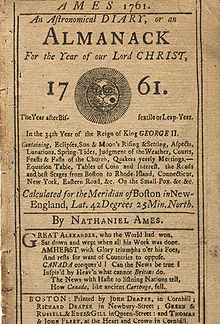Ames' Almanack (almanac) was the first almanac printed in the British North American colonies. While Benjamin Franklin's Poor Richard's Almanack is more widely known, the Ames' Almanack had a much larger readership. Franklin's publication had a circulation of 10,000 copies compared to 60,000 for the Ames' Almanack.[1]
 Cover of Ames Almanack in 1761 | |
| Author | Nathaniel Ames (1725-1764) Nathaniel Ames (1764-1775) |
|---|---|
| Country | United States |
| Language | English |
| Genre | Almanac |
| Published | 1725-1775 |
History edit
Nathaniel Ames, a second generation colonial American, was the founder and publisher of the Ames' Almanac.[2] The first edition was published when Ames was seventeen. His family owned Ames Tavern, which was often advertised in the almanac.[3] Upon Ames' death in 1764, his son, also Nathaniel, took over and continued to publish the almanac until 1775.[4]
The younger Nathaniel strongly supported the antifederalist cause, unlike his brother, Fisher Ames, who was a Federalist congressman. Correspondence between Ames and Roger Sherman in 1753 attests that Sherman wrote some of the mathematical portions of the almanac.[5]
Intellectual property edit
With no real intellectual property enforcement, readers frequently copied from the almanac. This led to bickering among printers as to who published the genuine edition of Ames' Almanack. Ames was asked to certify the original version.[6]
Legacy edit
Ames wrote during a time of growing American nationalism and this was reflected in the annual almanacs.[7] In 1775, when the American Revolution began, the almanac published a manual on how to make gunpowder so that every man could supply himself "with a sufficiency of that commodity."[8] As George Washington wrote to Congress, the Continental Army was "exceedingly destitute" of gunpowder.[9]
Ames took a stand on the religious Great Awakening running through the colonies in the early 18th century. The Great Awakening challenged the traditional authority of the congregationalist church. George Whitefield, an English evangelist, stirred up controversy in the colonies with his sermons. In 1741, Ames satirized critics of Whitefield in "To the Scoffers at Mr. Whitefield's Preaching." Four years later, Whitefield came to Ames' hometown of Dedham to give one of his sermons.[10]
The Old Farmer's Almanac, a popular annual publication in existence since 1792, copied the format used in the Ames' Almanack. This included page headings with the corresponding zodiac sign; left margin noting movable feasts, lines from a poem relevant to that month; phases of the moon; weather predictions; and anniversaries.[11]
Some early colonists used the blank pages of the almanac to keep personal diaries. The American Antiquarian Society collection in Worcester, Massachusetts holds at least two of these diaries, including that of Reverend Thomas Balch (1759).[12] Ebenezer Gay, a pastor at the Church at Hingham in Hingham, Massachusetts similarly recorded his visits to Boston and days of prayer in his copy of the Ames Almanack.[13]
References edit
- ^ Jorgenson, Chester E. (Dec 1935). "The New Science in the Almanacs of Ames and Franklin". The New England Quarterly. 8 (4): 555–556. doi:10.2307/360361. ISSN 0028-4866. JSTOR 360361.
- ^ Drake, Samuel, ed., New England Historical and Genealogical Register, New England Historic Genealogical Society, p. 255.
- ^ Earle, Alice Morse; Cairns Collection of American Women Writers (1900). Stage-coach and Tavern Days. The Macmillan Company. pp. 164, 167.
- ^ Stowell, Marion Barber, Early American Almanacs; the Colonial Weekday Bible: The Colonial Weekday Bible, Ayer Publishing, 1977, p. 72.
- ^ Hamm, Margherita Arlina (1902). Builders of the Republic. J. Pott. pp. 153.
- ^ Tract. Western Reserve and Northern Ohio Historical Society, Bernard Shaw Society. 1888. p. 473.
- ^ Sidwell, Robert T (Autumn 1968). ""Writers, Thinkers and Fox Hunters". Educational Theory in the Almanacs of Eighteenth-Century Colonies". History of Education Quarterly. 8 (3). History of Education Society: 279. doi:10.2307/367428. ISSN 0028-4866. JSTOR 367428.
- ^ Winsor, Justin (1888). Narrative and Critical History of America. Houghton, Mifflin and company. p. 118.
- ^ Volo, James M. (2003). Daily life during the American Revolution. Greenwood Publishing Group. pp. 151–152. ISBN 978-0-313-31844-3.
- ^ Stowell, Marion Barber (Fall 1983). "The Influence of Nathaniel Ames on the Literary Taste of His Time". Early American Literature. 18 (2). University of North Carolina Press: 133. ISSN 0012-8163.
- ^ Morison, Samuel Eliot and S. E. Morison, Squire Ames and Doctor Ames, The New England Quarterly, Vol. 1, No. 1 (Jan., 1928), pp. 7.
- ^ Williams, Julie Hedgepeth (1999). The Significance of the Printed Word in Early America: Colonists' Thoughts on the Role of the Press. Greenwood Publishing Group. p. 205. ISBN 978-0-313-30923-6.
- ^ Lacey, Barbara E. (Summer 1991). "Gender, Piety, and Secularization in Connecticut Religion, 1720-1775". Journal of Social History. 24 (4). Peter N. Stearns: 814. doi:10.1353/jsh/24.4.799. ISSN 0022-4529.